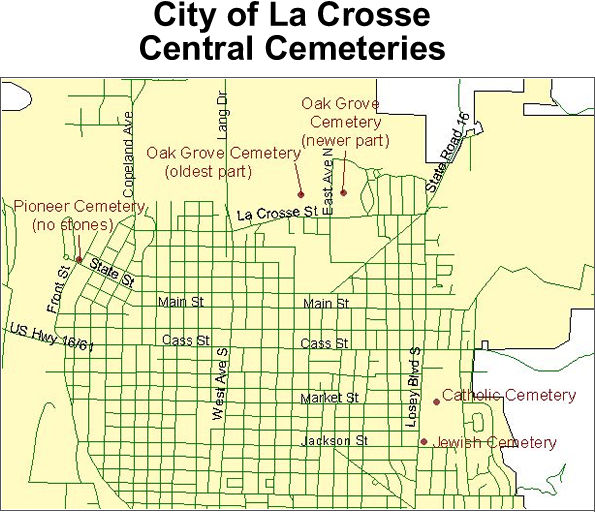Jewish/Ansche Chesed

The beginnings of the Jewish Cemetery in La Crosse is deeply intertwined with the pioneers who were of Jewish faith. The first person of the Jewish faith to arrive in La Crosse was John M. Levy in 1845, only three years after the founding of La Crosse by Nathan Myrick. Many consider Levy to be the first permanent white settler in La Crosse, since the Myrick left La Crosse for St. Paul in 1848. The first religious services held in the tiny village of Prairie La Crosse were held in John Levy's house at which all denominations were represented. Levy was well respected and elected as three-time mayor after La Crosse became a city in 1856. Most of the early Jewish settlers were in the mercantile business.
Myer Katz, author of several articles on Jewish history of La Crosse, divides this history into four chronoical periods. The first is that of the "Deutsche Yehudim" or the German Jews who fled Germany after the Revolution of 1848. Most immigrants of this period landed in New York and stayed there or in other large eastern cities. The more adventurous came west to seek their fotunes and establish homes. This first wave of German Jewish immigration brought 22 families to La Crosse.
The Congregation that developed in La Crosse was of the Reformed rather than the Orthodox Jewish Faith. The constitution of the Hebrew Indigent, Sick and Burial Society was adopted May 18, 1857, according to an article by Harry J. Hirshheimer titled, "Jewish Settlers of La Crosse Prior to 1880," in the La Crosse County Historical Society's La Crosse County Historical Sketches, series 2 (La Crosse, WI : 1935).
Organizers of the community of faith were Louis Hirshheimer, Isaac Tuteur, N. Scharff, and H. Gutman, while other members included M. Gutman, Isaac Cantrovitz, A. Patz, Joseph Gutman, Sigmund Gutman, A. Waldauer, A. Lederman, L. Shrier, B. Scharff (Scharpf), O. W. Prager, W. Bennett, and Levi Strauss. It was later called the Hebrew Benevolent Society and became Congregation Ansche Chesed, on Sept. 8, 1878, being formally incorporated Sept. 1, 1896. In 1905 this group had only 14 members.
The congregation was very small and as a result could not support a full-time rabbi. Other than holy days when a regular rabbi was employed, services were conducted by the elder members, among them John M. Levy, A. Patz, H. Fox. During the 1870's and into the early 1880's, religious education for youth was conducted. However, after this time period, membership had dwindled to the point where even covering the expenses for a rabbi during the ten day holiday period was impossible. It is noted, however, that most of the original members who had moved away from La Crosse during the eighties and later, kept up their Cemetery Association dues. This enabled the remaining members to maintain the property.
On July 12, 1857, a Congregational committee reported the purchase of one acre of land for a burial ground at $150.00. However, the deed was not recorded until April 12, 1870, from Joseph Ebner to S. Neuman and N. Steinam, trustees for the Congregation. The mother of Louis Hirshheimer, Mrs. Sarah Hirshheimer Hindle, who was born in 1768 and died in June 1858 in La Crosse, was the first burial at the Jewish Cemetery. In 1889, Mons Anderson, the Norwegian "Merchant Prince" of La Crosse offered to sell 3 acres of land adjoining the cemetery at $150 per acre, the same price per acre as the original cemetery purchase. The committee instead offered $250 for three acres.
The second period of Jewish immigration to the United States ranged from 1890 to 1915 and consisted mainly of traditional Orthodox Jews from eastern Europe. While the beginnings of organized services in La Crosse may have been shakey, the Jewish community in the later nineteenth century began to see an influx of these Orthodox Jews. This included families such as Omerberg, Getts, Wolfson, Natenshon, Feinberg, Goldish, Weisbord, Jacobs and others. Shortly after the turn of the twenthieth century, the Sons of Abraham Congregation was formed under the leadership of Abraham Goldish. This group built a synagogue and continues to hold regular services.
The third period of Jewish movement to La Crosse inlucdes those who arrived from about 1915 to 1950. This signaled a rise of the conservative movement among the La Crosse Jewish community, while the fourth wave of immigration began at the end of World War II and continues to the present time.
Katz notes that during the early days when both German Reformed Jews and middle eastern European traditional Jews lived in La Crosse, they maintained a separate social culture and independent synagogues. Today all three groups cooperate as a single community of faith -- socially, culturally and religiously -- without friction.
Search our online cemetery database
Plat or section map of Ansche Chesed Cemetery as filed with the County Register of Deeds
Census List Details:
